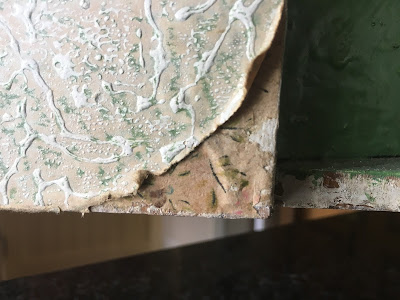Westacre furniture was hand-made in Norfolk, England in the 1920s and 30s.
Firstly, there is this black lacquered settee which would originally have had two little bead-trimmed cushions, one at either end, most likely made from a fine silk, in a colour to match the Liberty lawn seat cushion.
And secondly, there is this black lacquered chair.
I would have liked to have identified the Liberty print, which looks like William Morris to me, but I can't find it anywhere on the internet!
The lacquered back of the settee has a finely-painted figure on it.
And the chair back shows a typical oriental scene of weeping willow, a pagoda and a figure carrying a water yoke.
The furniture was made with a wire frame, covered in papier mâché. Card was added to represent seats and seat backs and then the whole piece is lacquered before being finely painted with gold detailing.
Stiffened pillow lace (lace made by hand using a lace pillow) has been used to represent 'canework' on the back of the settee and the seat of the chair.
On the settee, the pillow lace is wrapped around the frame at the back and, I think, sewn on to it.
Stiffened pillow lace (lace made by hand using a lace pillow) has been used to represent 'canework' on the back of the settee and the seat of the chair.
On the settee, the pillow lace is wrapped around the frame at the back and, I think, sewn on to it.
Despite the distinctly hand-made look of Westacre furniture, the quality and detailing are excellent.
This photo shows the raised 'carving' at the top of the chair back.
I love information and so I love this label!
Liza Antrim's excellent book, 'Family Dolls' Houses of the 18th and 19th Centuries' [from which I obtained most of my information for this post], tells us that Westacre furniture was sold by Morrell's toy shop in the Burlington Arcade, London and this label would indicate that it was also sold by Liberty & Co, London.
Liza's book contains a photograph of a wholesale price list for the furniture and this "Lacquered Settee" is listed as costing 45 shillings for one dozen, so 3 shillings and 9 pence for one of them. I don't know the exact date of either the wholesale price list or this label but it does look as if the retail mark-up was around 100%.
According to an on-line calculator I found (Concertina.com), the Liberty & Co retail price of 6 shillings and 11 pence in 1930 would equate to around £49, and whilst these calculators aren't completely reliable, it would seem that the furniture was pretty pricey!
I understand that Wesacre furniture comes in several different sizes, but my two new pieces are both of the smaller size - roughly 1:16 and here is the settee looking slightly diminutive in my 1:12 scale Triang 81. The settee is 9.5 cm wide (or, just a pinch under 4 inches).
Though still looking small, it definitely looks better suited to this more 1:16 scale room in my G&J Lines No. 5.
I like it here and it's English like the house, so it makes sense to be there - but who knows if it will stay?!
Until next time,
Zoe



















































